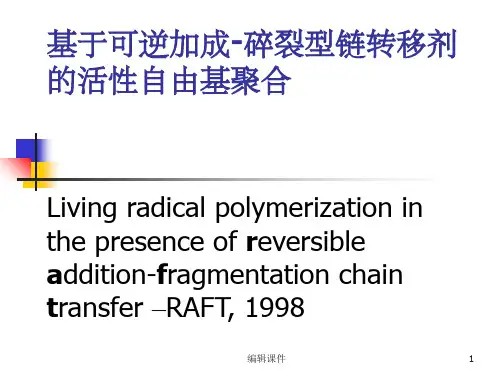活性自由基聚合 英文幻灯片
- 格式:ppt
- 大小:1.76 MB
- 文档页数:20
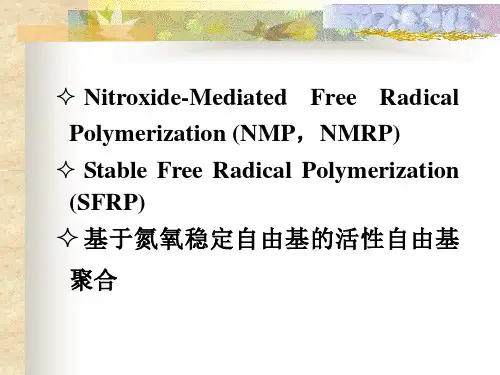
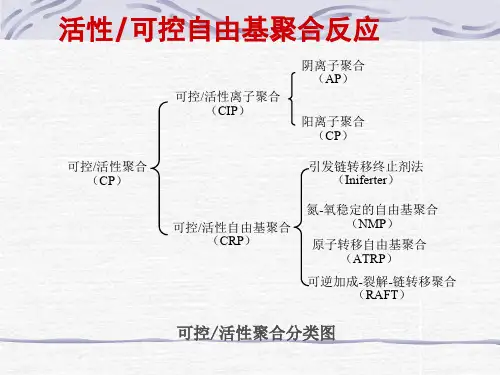
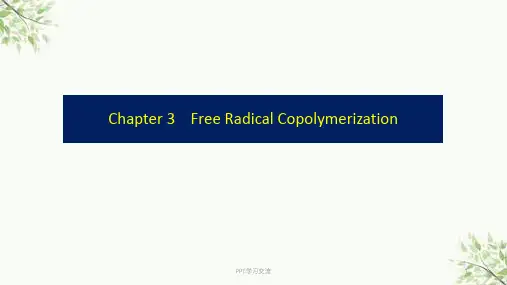

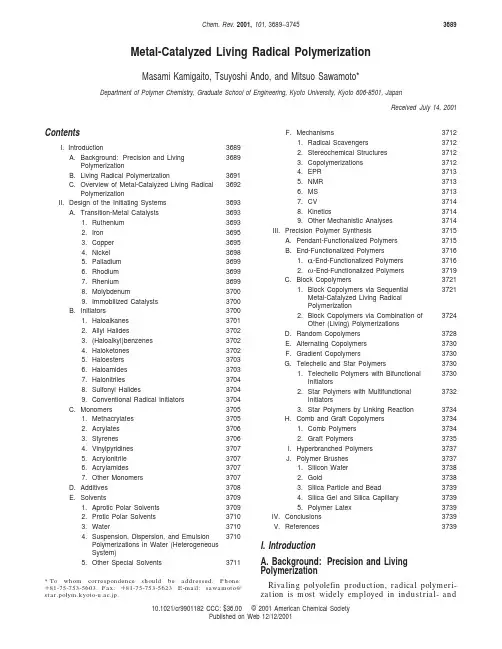
Metal-Catalyzed Living Radical PolymerizationMasami Kamigaito,Tsuyoshi Ando,and Mitsuo Sawamoto*Department of Polymer Chemistry,Graduate School of Engineering,Kyoto University,Kyoto606-8501,JapanReceived July14,2001ContentsI.Introduction3689A.Background:Precision and LivingPolymerization3689B.Living Radical Polymerization3691C.Overview of Metal-Catalyzed Living RadicalPolymerization3692 II.Design of the Initiating Systems3693A.Transition-Metal Catalysts36931.Ruthenium36932.Iron36953.Copper36954.Nickel36985.Palladium36996.Rhodium36997.Rhenium36998.Molybdenum37009.Immobilized Catalysts3700B.Initiators37001.Haloalkanes37012.Allyl Halides37023.(Haloalkyl)benzenes37024.Haloketones37025.Haloesters37036.Haloamides37037.Halonitriles37048.Sulfonyl Halides37049.Conventional Radical Initiators3704C.Monomers37051.Methacrylates37052.Acrylates37063.Styrenes37064.Vinylpyridines37075.Acrylonitrile37076.Acrylamides37077.Other Monomers3707D.Additives3708E.Solvents37091.Aprotic Polar Solvents37092.Protic Polar Solvents37103.Water37104.Suspension,Dispersion,and EmulsionPolymerizations in Water(HeterogeneousSystem)37105.Other Special Solvents3711F.Mechanisms37121.Radical Scavengers37122.Stereochemical Structures37123.Copolymerizations37124.EPR37135.NMR37136.MS37137.CV37148.Kinetics37149.Other Mechanistic Analyses3714III.Precision Polymer Synthesis3715A.Pendant-Functionalized Polymers3715B.End-Functionalized Polymers37161.R-End-Functionalized Polymers37162.ω-End-Functionalized Polymers3719C.Block Copolymers37211.Block Copolymers via SequentialMetal-Catalyzed Living RadicalPolymerization37212.Block Copolymers via Combination ofOther(Living)Polymerizations3724D.Random Copolymers3728E.Alternating Copolymers3730F.Gradient Copolymers3730G.Telechelic and Star Polymers37301.Telechelic Polymers with BifunctionalInitiators37302.Star Polymers with MultifunctionalInitiators37323.Star Polymers by Linking Reaction3734b and Graft Copolymers3734b Polymers37342.Graft Polymers3735I.Hyperbranched Polymers3737J.Polymer Brushes37371.Silicon Wafer37382.Gold37383.Silica Particle and Bead37394.Silica Gel and Silica Capillary37395.Polymer Latex3739IV.Conclusions3739 V.References3739 I.IntroductionA.Background:Precision and Living PolymerizationRivaling polyolefin production,radical polymeri-zation is most widely employed in industrial-and*To whom correspondence should be addressed.Phone: +81-75-753-5603.Fax:+81-75-753-5623.E-mail:sawamoto@ star.polym.kyoto-u.ac.jp.3689Chem.Rev.2001,101,3689−374510.1021/cr9901182CCC:$36.00©2001American Chemical SocietyPublished on Web12/12/2001laboratory-scale processes for polymer synthesis,because of its tolerance to protic compounds such as water,a high reaction rate,a polymerization tem-perature usually higher than ambient,and other advantages.1Unlike ionic reaction intermediates,however,the growing radical species therein usually suffers from bimolecular termination reactions such as radical recombination and disproportionation (Scheme 1).Radical polymerization had thus been considered unsuitable for precision polymer synthe-sis,in contrast to the ionic counterparts where the growing species are inherently repulsive to each other.One of the most effective methods for precision polymer synthesis is “living”polymerization,the first example of which was discovered in the anionic polymerization of styrene with sodium naphthalenide in 1956.2Living polymerization is free from side reactions such as termination and chain transfer and can thus generate polymers of well-defined architec-tures and molecular weights,i.e.,one polymer chain per molecule of initiator.When the initiation is faster than,or at least comparable in rate to,propagation,the obtained polymers have narrow molecular weight distributions (MWDs)where the ratio of weight-average to number-average molecular weight (M w /M n )is around 1.1.In general,however,living anionic polymerization was limited to nonpolar hydrocarbon monomers such as styrenes and 1,3-dienes at first,but has now been developed to polar monomerssuchMasami Kamigaito was born in 1965in Nagoya,Japan.He received his B.S.and M.S.degrees and Ph.D.degree in polymer chemistry from Kyoto University in 1993under the direction of Professor Toshinobu Higashimura.After postdoctoral research with Professor Mitsuo Sawamoto,he joined the faculty at Kyoto University in 1995,where he is now Associate Professor of Polymer Chemistry.In 1997−1998,he was a visiting scientist under Professor Robert M.Waymouth at Stanford University.He is the recipient of the 1999Award for the Encouragement of Research in Polymer Science of the Society of Polymer Science,Japan,and the 2001Arthur K.Doolittle Award of the ACS PMSE Division.His research interests include metal catalysis for precision polymer synthesis,particularly living cationic and radicalpolymerization.Tsuyoshi Ando received his bachelor degree in 1995,master degree in 1997,and Ph.D.degree in 2000from Kyoto University.His doctoral study was on the development of transition-metal-catalyzed living radical polymerization systems under the direction of Professor Mitsuo Sawamoto,where he received a Research Fellowship for Young Scientists of the Japan Society for the Promotion of Scientists (1998−2000).He joined the Kyoto University faculty,Department of Polymer Chemistry,Faculty of Engineering,as a research instructor in 2000.His research activity is focused on controlled reactions,including precision polymerization,catalyzed by metalcompounds.Mitsuo Sawamoto,born in Kyoto,Japan (1951),received his B.S.(1974),M.S.(1976),and Ph.D.(1979)degrees in polymer chemistry from Kyoto University under the direction of Toshinobu Higashimura.After postdoctoral research with Joseph P.Kennedy at the Institute of Polymer Science,The University of Akron,Akron,OH (1980−81),he joined the faculty of the Department of Polymer Chemistry,Kyoto University,in 1981as a research instructor.He was promoted to Lecturer (1991),to Associate Professor (1993),and to Professor (1994),his current position,of the same department.Sawamoto also serves as one of the three Editors of the Journal of Polymer Science,Part A:Polymer Chemistry (1995−present)and as an Editorial Advisory Board member of Macromolecular Chemistry and Physics ,the Journal of Macromolecular Science,Chemistry ,and e-Polymers ,and is the recipient of the 1991Award of the Society of Polymer Science,Japan,the 1998Divisional Award of the Chemical Society of Japan,the 2001Aggarval Lectureship in Polymer Science,Cornell University,and the 2001Arthur K.Doolittle Award of the ACS PMSE Division.With more than 250articles and reviews,his research interest covers living radical and cationic polymerizations,precision polymer synthesis,and the chemistry of radical and carbocationic reaction intermediates.Scheme 1.Elementary Reactions for Conventional RadicalPolymerization3690Chemical Reviews,2001,Vol.101,No.12Kamigaito et al.as(meth)acrylates and other functional derivatives.3-6 Similar proliferation has recently occurred in other polymerizations,including cationic,7-9coordination,10 ring-opening,11and ring-opening metathesis,12for which precise reaction control had been considered difficult for some time.In this regard,living radical polymerization has been among the most challenging frontiers in precision polymer synthesis and polymer chemistry.B.Living Radical PolymerizationGiven this rapid progress in precision polymeriza-tion,living radical polymerization had been one of the most difficult subjects.The difficulty primarily stems from the inherent and“built-in”bimolecular termination of the growing radicals,and the prevail-ing consensus was(or still is)that it might not be suppressed,though not impossible.Starting with the pioneering works by Otsu et al.in the1980s,13,14 however,the number of studies on living radical polymerizations started to mushroom,especially in the1990s.There are now numerous systems and pro-posed methodologies for controlling radical polymer-izations,even in comparison to some of the“classical”anionic living polymerizations.Typical examples of these systems are summarized in eqs1-9.At first glance,the examples vary clearly in mech-anism or in chemicals to be employed,but impor-tantly,the concept or the strategy for controlling radical polymerization appears to be common,namely, to lower the(instantaneous)concentration of a grow-ing radical species by introducing a covalent dormant species that exists predominantly over,and in fast equilibrium with,the growth-active radical species. Such a dynamic and rapid equilibrium not only minimizes the extent or probability of the radical bimolecular termination but also gives an equal opportunity of propagation to all polymer(or dor-mant)terminals via the frequent interconversion between the active and the dormant species.These features thus lead to nearly uniform chain length (molecular weight)determined by the molar ratio of monomers to the dormant species(or the initiator). Another factor for consideration is the so-called “persistent radical”,15a relatively stable radical that does not react with its own kind but does combine with the growing end.Its importance has been pointed out to be necessary for the control,as reviewed by Fischer in this issue.The covalent bonds for dormant species include C-C(eq1),16,17C-S(eqs2and9),13,14,18C-Se(eq 3),19C-O(eqs4and5),20-25C-halogen(eqs6and 8),26-28and C-metal(eq7),29all of which can reversibly and homolytically be activated into the growing radical species by physical stimuli such as heat or light or by chemical stimuli such as a metal catalyst or another radical species.Although the controllability,applicability,and reaction conditions depend on which systems are employed,a wide variety of vinyl monomers such as styrenes,meth-acrylates,acrylates,dienes,and vinyl acetate can be polymerized in a controlled fashion with the use of these or similar systems.Among these,nitroxide-mediated(eq4)20-24and metal-catalyzed27,28systems (eq6)have most extensively been studied,probably due to the high controllability,the wide applicability, and the relatively easy access to the catalysts and other components to be employed.This review primarily covers the metal-catalyzed living radical polymerizations.As will be discussed, their advantages include dual control of the growing end by the terminal halogen and the metal complex, relatively low temperatures needed(60-100°C),and commercially available compounds used;among oth-ers,the nitroxide-mediated living radical polymeri-zation is reviewed in this issue by Hawker.Another metal-mediated living radical polymerization is based on carbon-metal bonds such as carbon-cobalt(eq 7)29and others,which fall outside the scope of this review,because the metals therein do not serve as the catalysts.Some reviews on this topic are avail-able,30,31and it is closely related to catalytic chain transfer32reviewed by Gridnev and Ittel in a separate paperherein.Metal-Catalyzed Living Radical Polymerization Chemical Reviews,2001,Vol.101,No.123691C.Overview of Metal-Catalyzed Living Radical PolymerizationMetal-catalyzed living radical polymerization can be traced back to metal-catalyzed radical addition reactions to alkenes,sometimes collectively called Kharasch or atom-transfer radical addition (ATRA)reactions in organic chemistry (Scheme 2).33Thus,aradical species generated from an organic halide (R -X,X )halogen)or a related compound in the presence of a metal catalyst attacks an unsaturated compound (e.g.,CH 2d CHR ′)to form an adduct (R -CH 2-CHR ′-X)with a carbon -halogen bond.The metal catalyst thus undergoes a reversible one-electron redox reaction via abstraction of the halogen from the reactant R -X,followed by a one-electron reduction,i.e.,release of the halogen now attached to the oxidized metal back to the resulting radical species (R •).The reaction therefore proceeds catalyti-cally and in a chain reaction mechanism,with a high chemo-and regioselectivity,to give the adduct in a high and often quantitative yield,in sharp contrast to other addition reactions via radical intermediates.This is due to the controlled formation of the radical intermediates via metal catalysis,although it is not clear whether free radicals,metal-complexed radi-cals,or organometallic intermediates are involved.In any case,these features would lead to the follow-ing hypothesis:i.e.,if the carbon -halogen bond in the adduct is successively activated by the metal complex,a controlled radical polymerization will similarly proceed via the metal-assisted repetitive activation and formation of the carbon -halogen bond (dormant species)at the polymer chain end.This idea was indeed realized around 1994,which is when we reported the first example,i.e.,the living polymerization of methyl methacrylate catalyzed by a ruthenium(II)complex coupled with carbon tetra-chloride as the initiator.27Shortly after this,an independent report was published for a similar system with styrene and a copper catalyst,which was coined atom-transfer radical polymerization (ATRP)after the predecessor in organic chemistry.28In these examples,however reminiscent to classical free radi-cal polymerizations they might be,the number-average molecular weights of the polymers increase in direct proportion to monomer conversion and agree well with the calculated values assuming that one molecule of the halide initiator generates one polymer chain.The molecular weight distributions (MWDs)are as narrow as with the polydispersity (M w /M n )below or close to 1.1,comparable to those in living anionic polymerizations.The metal-catalyzed living radical polymerization thus proceeds (or at least is mostly considered to proceed)via reversible activation of carbon -halogen terminals by the metal complex,where the metal center undergoes redox reactions via interaction with the halogens at the polymer terminal,as shown in Scheme 3.The reaction is usually initiated by theactivation (homolytic cleavage)of the carbon -halo-gen bond in an appropriate organic halide (R -X)via one-electron oxidation of the metal center (M n X n L m )to form an initiating radical species (R •)and an oxidized metal compound (M n +1X n +1L m ).The R •reacts with the halogen on the oxidized metal to regenerate R -X or adds to the monomer to generate a radial species [R -CH 2-C(R 1)(R 2)•].It is sooner or later transformed into the adduct [R -CH 2-C(R 1)(R 2)-X]of R -X and the monomer via abstraction of a halogen atom from M n +1X n +1L m .The carbon -halogen bond of the adduct is subsequently activated by the metal complex,similarly to R -X,to result in a similar carbon -halogen bond at the polymer terminal via a repetitive set of the reactions.The key factors for these reactions are the low concentration of the radical intermediates at a given time and their fast but reversible transformation into the dormant spe-cies before undergoing successive addition to mono-mers.In this reaction,one polymer chain forms per molecule of the organic halide (initiator ),while the metal complex serves as a catalyst or as an activator ,which catalytically activates,or homolytically cleaves,the carbon -halogen terminal.Therefore,the initiat-ing systems for the metal-catalyzed living radical polymerization consist of an initiator and a metal catalyst.The effective metal complexes include vari-ous late transition metals such as ruthenium,copper,iron,nickel,etc.,while the initiators are haloesters,(haloalkyl)benzenes,sulfonyl halides,etc.(see below).They can control the polymerizations of various monomers including methacrylates,acrylates,sty-renes,etc.,most of which are radically polymerizable conjugated monomers.More detailed discussion will be found in the following sections of this paper for the scope and criteria of these components (initiators,metal catalysts,monomers,etc.).The metal-catalyzed living or controlled radical polymerizations can apparently be distinguishedScheme 2.Metal-Catalyzed Radical Addition Reaction (Kharasch AdditionReaction)Scheme 3.Metal-Catalyzed Living RadicalPolymerization3692Chemical Reviews,2001,Vol.101,No.12Kamigaito et al.from the conventional radical polymerization that involves a metal-assisted formation of the initiating radical species via irreversible redox processes,al-though the initiating system for the latter also consists of two components,a metal complex and an organic halide.34,35In these examples,except for a few,36,37the control of molecular weights and MWDs is generally difficult.The use of effective telomers can also make the control of molecular weights better in low molecular weight regions.However,the control-lability is much better for the recently developed systems with reversible activation.A few reviews dealing with comparison between the new and the old metal-catalyzed systems are also available.30,38 This review covers mainly the scientific literature that has appeared in relevant journals until early 2001concerning the metal-catalyzed(or atom-transfer)living radical polymerization.The word “living”employed here simply refers to polymeriza-tions that provide control over the molecular weights, the molecular weight distributions,and the chain end reactivity as do other living polymerizations.Its definition and use criteria,along with the word “controlled”,are still under discussion and have recently been discussed elsewhere.39Thus,the dis-cussion on the difference between these words is not to be treated here.The review roughly consists of two parts,the scope and design of initiating systems followed by precision polymer synthesis.The former will treat the scope of metal catalysts,initiators,and monomers along with polymerization mechanisms.The latter will focus on the precision synthesis of various polymers with controlled structures and interesting properties or functions,such as block,end-functionalized,star, and other architecturally well-defined polymers.Other reviews are also available,comprehensive,31,40-44and relatively short,45-52dealing with the recent develop-ments of the field.II.Design of the Initiating SystemsThe initiating systems for the metal-catalyzed living radical polymerizations consist of a metal complex(or catalyst)and an initiator;the former allows the generation of radical species from the latter or the dormant polymer terminal.The choice of the metals and the initiators according to the monomer structures is crucial for controlling radical polymerizations.The rate and control of the polym-erization can also be increased by the addition of other compounds or by changing solvents.This first part will deal with the design of the initiating systems from the viewpoint of various components, i.e.,metal complex catalysts,initiators,monomers, additives,and solvents,as well as the relevant reaction mechanisms.A.Transition-Metal CatalystsOne of the most important components in the metal-catalyzed living radical polymerization is the transition-metal complex.As a catalyst,the complex induces reversible activation(homolytic cleavage)of a dormant carbon-halogen bond at a polymer ter-minal via a one-electron redox reaction of the metalcenter.In this process,the metal center attacks thehalogen at the chain end and is oxidized via a singleelectron transfer followed by halogen abstraction,thus generating a growing radical species.Sooner orlater,the oxidized metal center donates the halogentherein back to the radical growing species,alongwith reduction of the metal center,before or after thepropagation reaction between the radical and mono-mer.The lower oxidation state of the metal center[e.g.,Ru(II)]should be more stable than its highercounterpart[e.g.,Ru(III)]so as to establish anextremely low concentration of the radical species aswell as a fast reversible reaction with the halogen.This set of reactions,i.e.,the activation/cleavageof a carbon-halogen bond,the formation of a radicalspecies,the repetitive addition(propagation)of theradical species to the monomer,and the regenerationof the carbon-halogen bond,are called the Kharaschor ATRA reactions.There are various metal com-plexes active for these reactions,as have been utilizedin organic synthesis.Indeed,some of the metalcomplexes active for living radical polymerizationwere originally developed for the small-moleculereactions,but along with the recent advances inpolymerization,new and more active complexes haveemerged,too.Although there are still no consistentrules for designing catalysts,there have been severalpapers dealing with the relationships between themetal center,catalyst structure,or ligand and theircatalytic activities.53,54In general,it is suggested thatthe catalytic activity increases with increasing elec-tron density of the metal center or with decreasingredox potential of the complex,because,upon theonset of radical generation,the catalyst should giveone electron to the halide terminal.The followingsections will focus on the transition-metal catalystsemployed for living radical polymerization.1.RutheniumThis group8transition metal was one of the firstwhose complexes[RuCl2(PPh3)3etc.,Ph)C6H5]weredemonstrated to induce living radical polymeriza-tion.27Among the various oxidation states of ruthe-nium complexes(-2to+6),the divalent form withphosphine ligands has effectively been employed forthe metal-catalyzed living radical polymerization aswell as Kharasch addition reactions(Figure1).Thedichloride RuCl2(PPh3)3(Ru-1)was the first complexemployed for the metal-catalyzed living radical po-lymerization of methyl methacrylate(MMA)in con-junction with CCl4as an initiator in the presence ofa metal alkoxide such as MeAl(ODBP)2(ODBP)2,6-di-tert-butylphenoxy)as an additive.27In toluene at60°C,the polymerization proceeded homogeneouslyto give polymers with molecular weights that werecontrolled by the feed ratio of monomer to initiatorand relatively narrow MWDs(M w/M n≈1.3).The radical nature of the polymerization was suggestedby inhibition of the polymerization on addition of aradical scavenger or inhibitor such as galvinoxyl and2,2,6,6-tetramethyl-1-piperidinyloxy(TEMPO).27,55Thetacticity of the polymers was similar to that preparedin conventional radical systems.27Metal-Catalyzed Living Radical Polymerization Chemical Reviews,2001,Vol.101,No.123693The ruthenium-catalyzed polymerization was fur-ther improved by using CHCl 2COPh and Al(O-i -Pr)3in place of CCl 4and MeAl(ODBP)2,respectively,resulting in very narrow MWDs (M w /M n )1.1)of poly(MMA).56This complex can also be applicable for styrene polymerization in conjunction with an iodo initiator to give relatively narrow MWDs (M w /M n ≈1.2).57A similar PPh 3-based ruthenium(II)hydride (Ru-2)is more active than the chloride Ru-1,thus inducing faster polymerizations.58The hydride com-plex is still active at 30°C to give polymers with narrow MWDs (M w /M n ≈1.2).A ruthenium complex with an ionic phosphine ligand (Ru-3),which is soluble in water or methanol,catalyzes homogeneous living radical polymerization of 2-hydroxyethyl meth-acrylate (HEMA)in methanol;59no protection of the hydroxyl group is required for HEMA.Among a series of the 18-electron half-metallocene-type ruthenium complexes (Ru-4,Ru-5,and Ru-6),the indenyl derivative Ru-5led to the fastest living radical polymerization of MMA.60In this case,addi-tives such as aluminum alkoxides are not necessary for controlled polymerization.However,addition of an amine such as n -Bu 2NH dramatically increased the rate to complete the polymerization in 5h at 100°C without broadening the MWDs.61Though less active,the Cp*complex Ru-6is a versatile catalyst,which enables living radical poly-merizations of three different types of monomers,i.e.,MMA,styrene,and methyl acrylate (MA),in conjunc-tion with a chloride initiator and Al(O-i -Pr)3.The initiating system with Ru-6gives controlled molec-ular weights and narrow MWDs (M w /M n )1.1-1.2)for all the monomers in toluene at 80°C without changing the initiator and reaction conditions ac-cording to the monomers.62The catalytic activity of these half-metallocene-type complexes increased in the order Ru-4<Ru-5<Ru-6;namely,the lower the redox potential of the complex,the faster the polym-erization.53Another half-metallocene-type ruthenium complex with 16-electrons (Ru-7)is more active than Ru-6,because the former has a vacant site that can interact with a halogen at the polymer terminal without release of phosphine ligand.62A trispyrazolyl borate-based complex (Ru-8),isoelectronic to 18-electron half-metallocene-type complexes,also in-duced living radical polymerization of MMA either with or without additives,where the rates and molecular weights were not changed on addition of Al(O-i -Pr)3.53A series of p -cymene-based ruthenium dichloride complexes (Ru-9)with various phosphines and re-lated two-electron-donor ligands was synthesized and used for the radical polymerizations of several mono-mers as well as Kharasch addition reactions.63,64Controlled polymerizations were achieved with basic and bulky phosphine or arsenic ligands (L )PCy 3,P(i -Pr)3,P(c -C 5H 9)3,PPhCy 2,AsCy 3,PCy 2CH 2CH 2-CH 2C 6H 5).Among them,the tricyclohexylphosphine complex (L )PCy 3)is most active and efficient in giving well-controlled molecular weights and narrow MWDs (M w /M n ≈1.1)for methacrylates.63In con-trast,less basic or less bulky phosphine-,pyridine-,isocyanide-,and antimony-based ligands led to less efficient and/or less controlled polymerizations.Simi-lar complexes carrying benzene (Ru-10)or tetralin (Ru-11)can also be employed;the activity decreased in the order p -cymene >benzene >tetralin.65A complex with a bridged ligand with arene and phosphine can be obtained via release of the p -cymene ligand from Ru-9(L )PCy 2CH 2CH 2CH 2C 6H 5)on heating to 120°C,but it was significantly less active than the precursor Ru-9(L )PCy 2CH 2CH 2-CH 2C 6H 5),which induces efficient living radical po-lymerization.65The activation process of these arene-based 18-electron complexes is thus release of arene ligands,which results in active and coordinatedly unsaturated 12-electron complexes.A series of so-called Grubbs ruthenium -carbene complexes (Ru-12)can mediate living radical polym-erization of MMA and styrene to afford controlled polymers with narrow MWDs (M w /M n ≈1.2).63,66The polymerization apparently proceeds via a radical mechanism,as suggested by the inhibition with galvinoxyl.For example,a novel ruthenium -carbene complex (Ru-13)carries a bromoisobutyrate group and can thus not only initiate but also catalyze living radical polymerization of MMA without an initiator.67Figure 1.Ruthenium catalysts.3694Chemical Reviews,2001,Vol.101,No.12Kamigaito et al.The complex is also active in ring-opening metathesis polymerization of 1,5-cyclooctadiene (COD),where the ruthenium -carbene bond is now the initiating point.Therefore,a mixture of MMA and COD un-dergoes a dual or tandem living polymerization of both monomers to generate block copolymers of COD and MMA,which can be converted into ethylene-block -MMA copolymers on subsequent hydrogena-tion,also catalyzed by the complex.Ruthenium -carborane 14-electron complexes were investigated as catalysts for the radical reactions,and among them,a hydride complex (Ru-14)proved effective in giving narrow MWDs (M w /M n ≈1.2)and controlled molecular weights without additives in the MMA polymerizations.68A binuclear azo-bridged complex with nitrogen ligands (Ru-15)can be em-ployed for MMA polymerization with CCl 4as an initiator to give polymers with relatively narrow MWDs (M w /M n )1.4-1.6).692.IronAs with ruthenium,iron belongs to the group 8series of elements and can similarly take various oxidation states (-2to +4),among which Fe(II),Fe-(I),and Fe(0)species have been reported to be active in Kharasch addition reactions.33For metal-catalyzed living radical polymerizations,several Fe(II)and Fe-(I)complexes have thus far been employed and proved more active than the Ru(II)counterparts in most cases (Figure 2).The iron-based systems are attractive due to the low price and the nontoxic nature of iron.FeCl 2(PPh 3)2(Fe-1)was first employed for the metal-catalyzed living radical polymerization of MMA in conjunction with a chloride or a bromide initiator,and the rate of the polymerization is faster than with RuCl 2(PPh 3)3.70The polymerization with Fe-1cata-lyst was best controlled when coupled with CH 3C-(CO 2C 2H 5)2Br as an initiator without additives in toluene at 80°C (M w /M n )1.1-1.3).A similar fast living polymerization of styrene and MMA can be achieved with an iron complex and a higher electron-donating ligand such as imidazolydene (Fe-2)inconjunction with a bromide initiator to result in narrow MWDs (M w /M n ) 1.1-1.3).71Addition of FeCl 3slowed the polymerization but narrowed the MWDs further (M w /M n )1.1).The use of Cp or Cp*-based ligands is also benefi-cial for the iron-based systems in controlling radical polymerization.For instance,FeCpI(CO)2(Fe-3,X )I)induced a living radical polymerization of styrene in conjunction with an iodide initiator [(CH 3)2C-(CO 2C 2H 5)I]in the presence of Ti(O-i -Pr)4to give very narrow MWDs (M w /M n )1.1)and controlled molec-ular weights.72The rate was increased with the use of the corresponding bromide,while the MWD was narrowed by replacement of Cp with Cp*.73A faster and controlled polymerization was possible with dinuclear Fe(I)complexes (Fe-5and Fe-6)in the absence of metal alkoxides.Mixtures of iron(II)halides (FeBr 2and FeCl 2)and ligands were also employed for living radical polym-erization.Similar controlled radical polymerizations of MMA and styrene were achieved with FeBr 2and nitrogen-and phosphine-based ligands such as n -Bu 3N,n -Bu 3P,and 4,4′-bis(5-nonyl)-2,2′-bipyri-dine.74Halide anions derived from ammonium or phosphonium salts [n -Bu 4NX (X )Cl,Br,I)and n -Bu 4PBr]were also available as ligands for FeBr 2to mediate controlled polymerizations of styrene,MMA,and MA,although the systems were hetero-geneous.75In search of less toxic ligands,dicarboxylic acids [NH(CO 2H)2,C 6H 4-1,3-(CO 2H)2,and HO 2CCH 2-CH 2CO 2H]76-79and acetic acid 78were used for FeCl 2,and the resulting complexes induced controlled po-lymerizations of MMA and styrene to give relatively broad MWDs (M w /M n )1.3-1.8).Fe(III)species can also be employed in a so-called reverse or alternative atom-transfer radical polym-erization (section II.B.9).A mixture of FeCl 3and PPh 3can mediate a controlled polymerization of MMA in the presence of AIBN to give similarly narrow MWDs (M w /M n )1.1-1.3).80An ammonium halide such as n -Bu 4NBr can be employed in place of PPh 3as a ligand for FeBr 3in the AIBN-initiated radical po-lymerization.743.CopperCopper catalysts have been extensively employed for the metal-catalyzed living or controlled radical polymerizations.Most of the polymerizations are conducted by a mixture of copper(I)bromide or chloride and a nitrogen-based ligand (Figure 3),and in select examples by isolated complexes (Figure 4).A wide variety of nitrogen ligands have been searched and employed (Figure 3),and they can be classified into bidentate (L-1to L-17,e.g.,bipyridines,pyri-dinimines,diamines),tridentate (L-18to L-26),quad-ridentate (L-27to L-33),and formaly hexadentate (L-34).An overview of some of these ligands has been described in recent papers.54,81The following gives specific examples of these ligands,though no system-atic relationship has been established between their activity or utility and structures.However,quite recent papers deal with the relationships between the structure and the activity for several ligands.82,83The Cu(I)-based initiating system was first re-ported for styrene polymerization by WangandFigure 2.Iron catalysts.Metal-Catalyzed Living Radical Polymerization Chemical Reviews,2001,Vol.101,No.123695。
